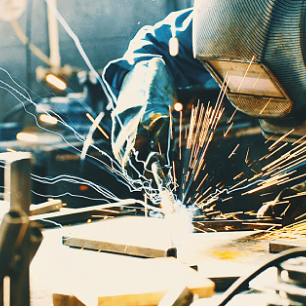Jump to:
Six Tips to Maintain a Safe and Compliant Dust Collection System
A dust collection system is essential for safety in welding, but if it’s not properly designed or maintained, the dust collector itself can also become a safety hazard. Follow these six tips to avoid dust collector disasters and maintain a safe, compliant system.
1. Material Filters
Welding fumes contain fine particulates that can quickly clog dust collector filters, reducing airflow and efficiency. Over-loaded or damaged filters can lead to higher system pressure, increasing fire risks and reducing performance. Damaged filters can also allow dust to escape the system, putting the facility out of compliance with health and safety standards.
To make sure filters are doing their job, follow these guidelines:
-Use high-efficiency filters designed for fine welding fumes (typically a MERV 15 or higher in the cartridge dust collection system).
-Monitor pressure drop across the filters (an indication of filter loading) and replace filters when pressure drop exceeds manufacturer specifications.
-Inspect filters regularly (including filter media, seals, and gaskets) and replace them if they show signs of wear or damage.
-Ensure the filter pulsing system is operational to extend filter life and ensure proper performance.
2. Keep Sparks out of the System
In welding operations and other metalworking applications, sparks present a considerable risk for the dust collection system. When sparks enter the dust collector, they can ignite filter media or cause a combustible dust explosion.
Here’s how you can protect your system:
-Use a spark arrestance system (such as a wire mesh spark trap or a centrifugal spark arrestor) to prevent sparks from entering the dust collector .
-If your operations generate a large number of sparks, a centrifugal system may provide more safety.
-In high-risk environments, consider a detect-and-suppress system, which detects sparks using a sensor system and extinguishes them with a water mist.
-Regularly clean and maintain spark arrestance systems to prevent the buildup of flammable material.
-Ensure your system is equipped with a smoke detector and an appropriate fire-suppression system.
3. Consider Combustible Dust Safety
Many welders assume that welding fumes are not combustible because they are fully oxidized, but that is not always the case. Unoxidized material in welding fumes may become an explosion risk under the right circumstances. In addition, welding often takes place in mixed-use environments with other metalworking applications, such as cutting, grinding, and finishing, that produce larger volumes of combustible metal dust.
These are the steps you can take:
-Evaluate your combustible dust risks. Depending on your operations, you may be required to complete a Dust Hazard Analysis (DHA) to remain in compliance with National Fire Protection Association (NFPA) guidelines.
-If your dust is combustible, the dust collector must be equipped with deflagration elements — including explosion venting isolation valves, and a rotary airlock for the dust collection bin — to mitigate the impact of an explosion inside the system.
4. Ground and Bond All Equipment
Static electricity is an often-overlooked hazard in dust collection systems, but it can pose a significant risk, especially in environments where combustible dust is present. As air and dust particles move through ducts and other system components, they can generate static charges. If these charges accumulate and are not safely dissipated, they can create a spark, an ignition source for combustible dust, leading to fires or explosions. Grounding and bonding are essential practices to mitigate this risk and ensure system safety.
To avoid these risks:
-Ensure all metallic parts of the dust collection system, including ducts, funnels, and the dust collector itself, are properly grounded using bonding straps or wires. This provides a path for static electricity to dissipate into the ground safely.
-Install ducts and connectors made from conductive materials, such as steel or aluminum. These materials allow static charges to flow freely to the grounding system.
-Use conductive gaskets and fasteners to maintain proper bonding at joints. Bonding ensures electrical continuity between all system parts, preventing isolated components from building up a static charge.
5. Regularly Inspect and Maintain the System
A proactive inspection and maintenance program is critical to identifying and resolving issues before they become safety hazards. Dust collection systems are complex, with multiple components that need to work together seamlessly to ensure safety and compliance. Regular maintenance helps reduce downtime, extend equipment life, and prevent accidents.
Steps to follow:
-Check fans, motors, dampers, and gaskets for signs of wear, damage, or inefficiency. Look for dust buildup in ducts and hoppers that could lead to blockages.
-Use pressure gauges and airflow monitors to track system performance and identify potential issues, such as excessive pressure drops or airflow imbalances.
-Develop a maintenance plan based on manufacturer recommendations and your operational demands. Conduct inspections at least quarterly and clean or service components as needed.
-Keep detailed records of inspections, repairs, and replacements to ensure compliance with OSHA and NFPA standards.
6. Implement Proper Dust Disposal Practices
Even with a well-maintained system, improper handling of collected dust can create new safety risks. Welding fume dust often contains fine particles and, in some cases, hazardous or combustible materials. Safe disposal is an integral part of maintaining a compliant and safe operation.
What you should do:
-Store collected dust in approved fire-resistant containers designed for safe handling and disposal.
-Prevent bins and hoppers from becoming overfilled by setting regular emptying intervals based on production volume. Overfilled bins can strain the system and create combustible hazards. Consider using a bin sensor to monitor fill levels.
-Dispose of collected dust according to local, state, and federal regulations, particularly if the dust contains hazardous materials.
-Ensure all workers handling dust are trained in safe disposal practices, including using personal protective equipment for toxic or hazardous dust and properly sealing containers to prevent spills or dust release.
Conclusion
Maintaining a safe and compliant dust collection system is essential for protecting workers and preventing costly incidents in welding operations. Following these tips can reduce risks, improve efficiency, and ensure compliance with industry standards. A proactive approach to system maintenance safeguards your facility and creates a healthier work environment for everyone.
This article was written by Jacques Kregting (new sales and application engineer, RoboVent) for the American Welding Society.


